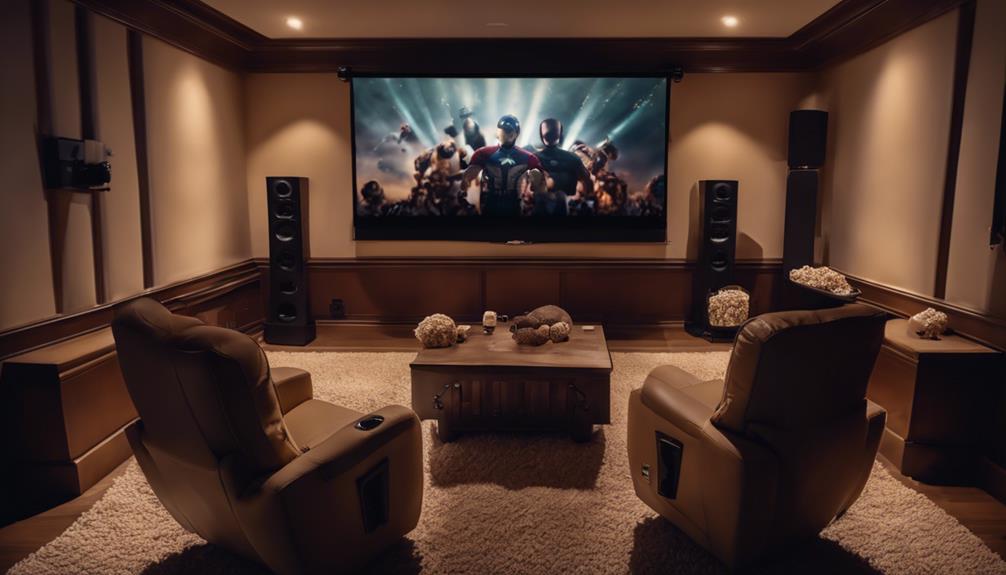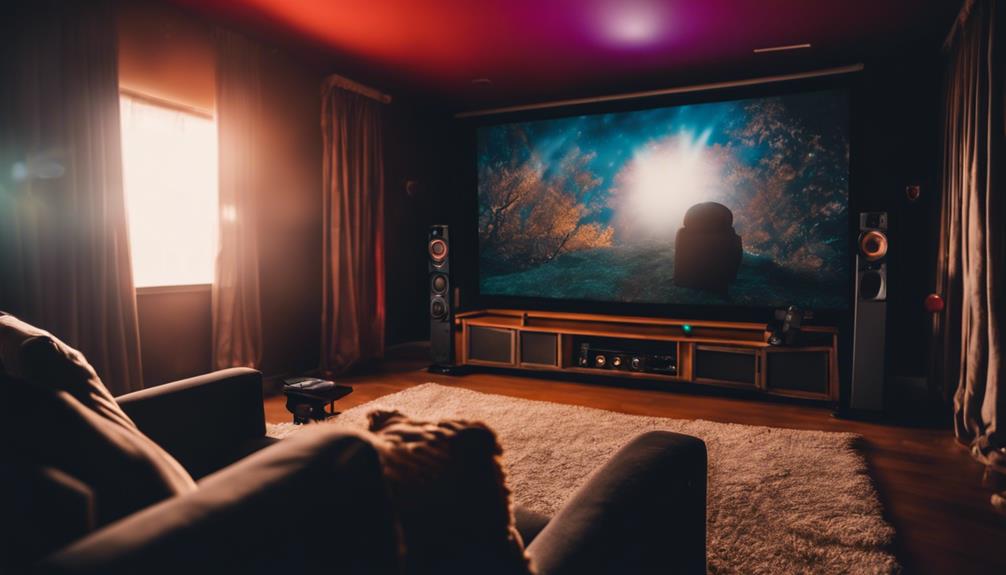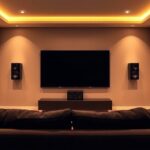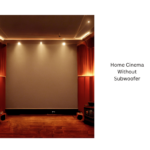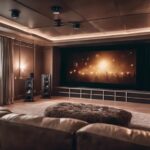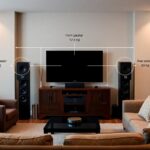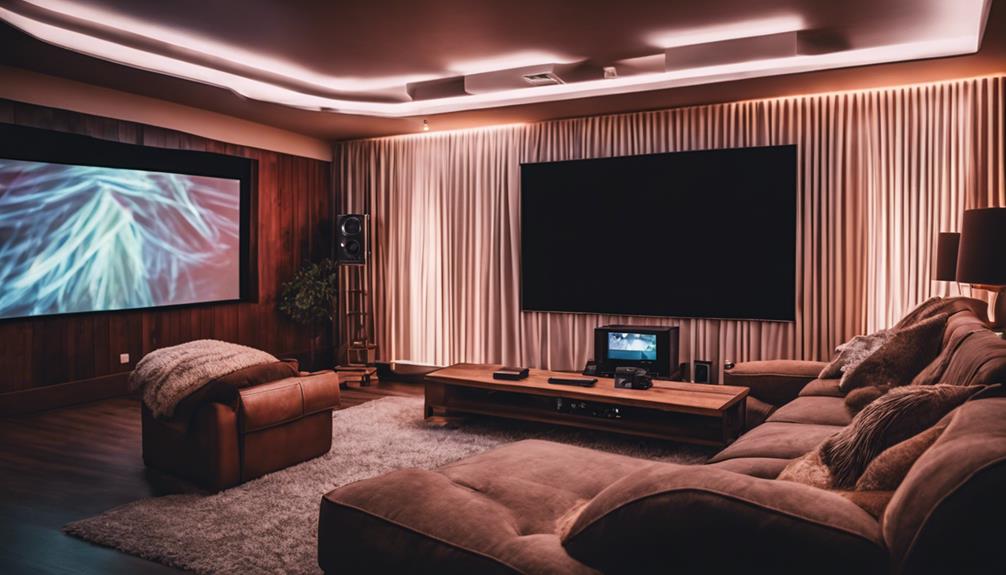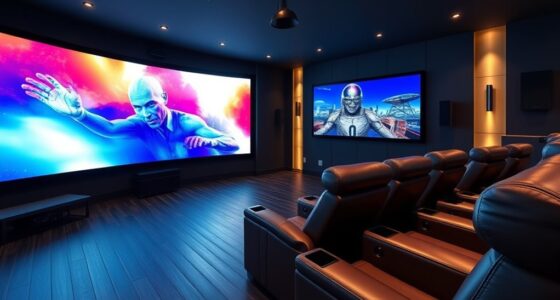Setting up surround sound transforms your home cinema into an immersive audio experience. Utilizing multiple speakers creates depth and clarity that enhances every scene. Proper speaker placement is vital, so make sure front speakers are at ear level and surround speakers are slightly elevated. Don't forget to take into account your room's acoustics; using rugs and curtains can help absorb unwanted echoes. With options like Dolby Atmos, you can achieve a truly three-dimensional sound. This setup not only boosts enjoyment but also deepens emotional connections to your favorite films. Stick around to discover more tips and techniques for the ultimate sound experience.
Key Takeaways
- Surround sound enhances the viewing experience by creating an immersive audio landscape with multiple speakers positioned strategically around the room.
- Proper speaker placement and calibration are essential for clear dialogue and balanced sound, maximizing the effectiveness of the audio system.
- Advanced formats like Dolby Atmos offer object-based sound, adding depth and a three-dimensional quality to your audio experience.
- Acoustic treatments, such as rugs and curtains, help absorb sound and minimize echo, improving overall audio clarity.
Understanding Surround Sound
Surround sound immerses you in audio by using multiple speakers placed around you, making movies, music, and games feel more realistic. This sound technology creates an immersive experience by utilizing configurations like 5.1, 7.1, or even 9.1 systems, which expand the audio landscape beyond traditional stereo sound. Proper speaker placement is vital; your center speaker needs to be positioned above or below the screen for clear dialogue, while surround speakers should sit slightly above ear level to enhance the overall effect.
Advanced formats like Dolby Atmos take this experience further by introducing height channels, allowing sounds to come from above, creating a three-dimensional sound environment that pulls you into the action.
To achieve the best performance from your surround sound system, proper calibration is imperative. This process guarantees balanced audio levels, allowing you to appreciate subtle details in soundtracks and effects that enrich your viewing experience.
Speaker Placement Essentials

When setting up your surround sound system, speaker height and arrangement are essential for the best audio experience.
You'll want front speakers at ear level and surround speakers positioned slightly above and behind you.
Optimal Speaker Height
Positioning your speakers at the right height is vital for achieving clear dialogue and an immersive audio experience. By confirming ideal speaker height, you enhance your system's performance and get the most out of your surround sound speakers.
Here are some key points to reflect on:
- Front speakers should be at ear level for ideal audio clarity in the main listening area.
- Surround speakers should be placed 1-2 feet above ear level to create that immersive surround sound experience.
- The center speaker, essential for dialogue, should sit directly above or below your television for a direct sound connection.
- Avoid placing speakers in corners, as this can lead to distortion and muddled sound, which diminishes overall audio quality.
Surround Speaker Arrangement
To create an immersive audio environment, place your surround speakers at ear level and slightly behind your main listening area. This positioning helps enhance the depth and directionality of sound effects, delivering an exceptional home theater experience.
For ideal sound staging, aim for a 90 to 110-degree angle from your main listening position. Consider investing in a quality headphone amplifier for an enhanced listening experience, as it can also improve the audio quality of your entire setup.
Make sure your surround speakers are at least 2-3 feet away from walls to reduce echoes and minimize potential distortion caused by room acoustics. If you're setting up a larger system like 7.1 or 9.1, consider adding extra surround speakers on the sides and rear to further enhance the immersive sound quality.
Using wall mounts or stands can help achieve the recommended height while ensuring that the sound paths remain unobstructed. This setup will allow for precise directional audio, ensuring that you feel enveloped in your favorite cinematic experience.
Room Acoustics Considerations
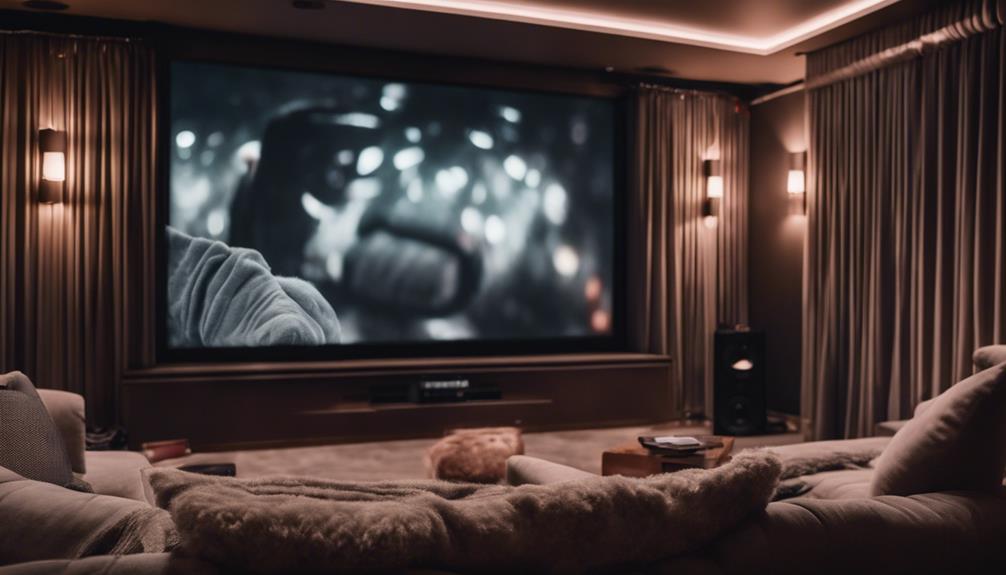
Understanding room acoustics is essential for achieving ideal sound quality in your surround sound setup. The way sound waves interact with your room can greatly affect your listening experience.
Here are some key considerations to keep in mind:
- Avoid hard surfaces like tile and glass that create echoes.
- Use acoustic treatments such as rugs, curtains, and wall panels to absorb sound.
- Make certain speakers are placed around the room thoughtfully, avoiding corners to prevent distortion.
- Maintain adequate space between speakers and walls for better sound dispersion.
Types of Surround Sound Systems
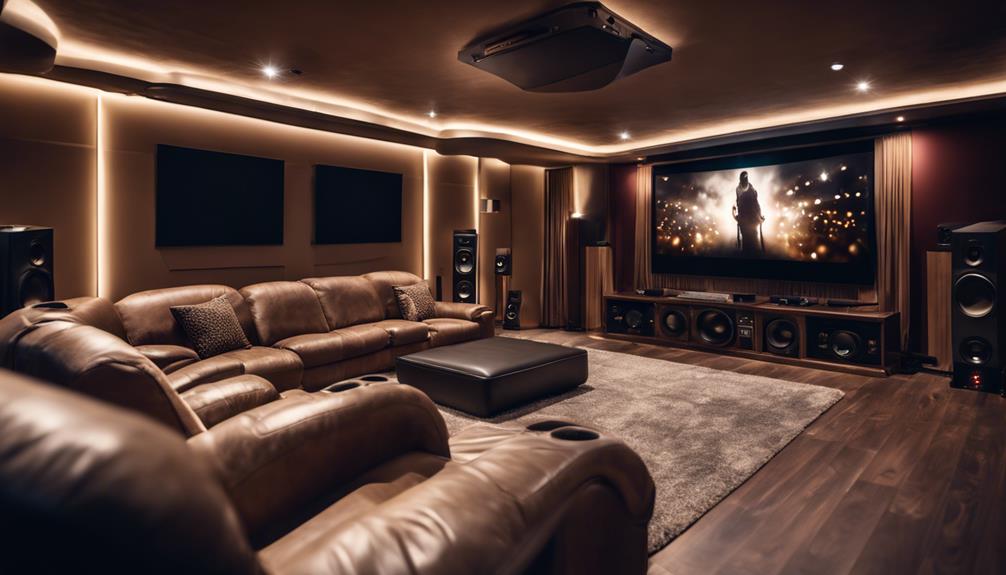
When choosing a surround sound system, you'll encounter various configurations like 5.1 and 7.1, each offering unique audio experiences.
You might also explore advanced formats such as Dolby Atmos, which adds a new dimension to sound placement.
Understanding these options will help you create a setup that truly enhances your home theater experience.
Common System Configurations
Surround sound systems come in various configurations, each designed to enhance your audio experience in different room sizes and setups. Understanding these configurations is key to achieving that immersive audio you crave in your home cinema.
Here are some common system configurations:
- 5.1 Surround Sound: Five speakers and one subwoofer, ideal for small to medium rooms.
- 7.1 Surround Sound: Adds two side speakers for a more enveloping sound experience, perfect for larger spaces.
- 9.1 Surround Sound: Incorporates front height speakers, enhancing sound depth and creating a more realistic audio experience.
- Dolby Atmos: This advanced surround sound format includes height channels, offering object-based audio placement for a three-dimensional soundscape.
No matter what configuration you choose, verify it's compatible with various media formats, like DVD, Blu-ray, and streaming services. This way, you can enjoy peak performance across all your audio sources and truly elevate your home cinema experience.
Advanced Audio Formats
Explore the world of advanced audio formats that elevate your listening experience, transforming ordinary sound into immersive, three-dimensional audio landscapes.
Two of the most popular formats are Dolby Atmos and DTS:X. Both provide object-based sound, allowing audio elements to move freely in a three-dimensional space. This means you can hear sounds coming from above or around you, enhancing the realism of your home theater.
To take full advantage of these advanced audio formats, consider investing in a 7.1 or 9.1 sound system. A 7.1 setup adds two surround speakers, while a 9.1 system introduces front height speakers, creating even greater depth and dimension in your audio performance. These configurations work seamlessly with Dolby Atmos and DTS:X, ensuring you capture the full essence of modern films and shows.
Make sure your sound systems are compatible with streaming services and physical media formats like Blu-ray, as many of these are mixed in advanced audio formats. By doing this, you'll maximize the capabilities of your surround sound setup, immersing yourself fully in the cinematic experience.
Enhancing Your Viewing Experience
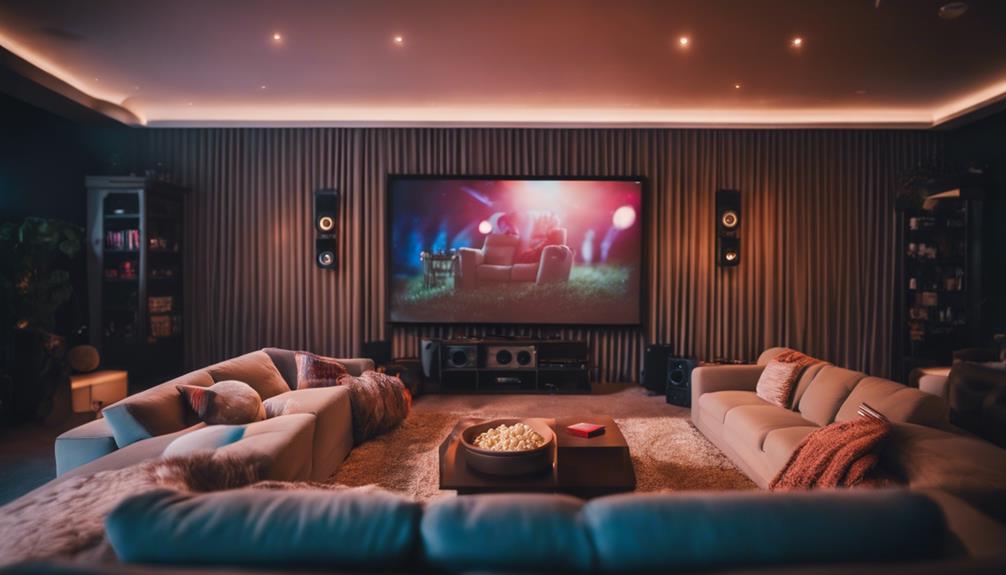
How can you elevate your movie nights to a whole new level with immersive audio that draws you into the action? Surround sound systems are essential for creating an unforgettable cinema experience at home. With the right setup, you'll enjoy realistic audio that enhances your emotional connection to films. Here are some key tips to keep in mind:
- Strategic placement of speakers around your room can create a three-dimensional soundstage, allowing sound to move seamlessly with visuals.
- Use height speakers for advanced setups (like 9.1) to add depth and dimension, making the action feel more engaging.
- Proper calibration of your audio system guarantees peak sound performance, allowing you to experience every detail and dramatic moment.
- Incorporate acoustic treatments, such as rugs and curtains, to improve sound clarity and reduce echoes, enhancing your overall viewing experience.
Maintenance and Setup Tips
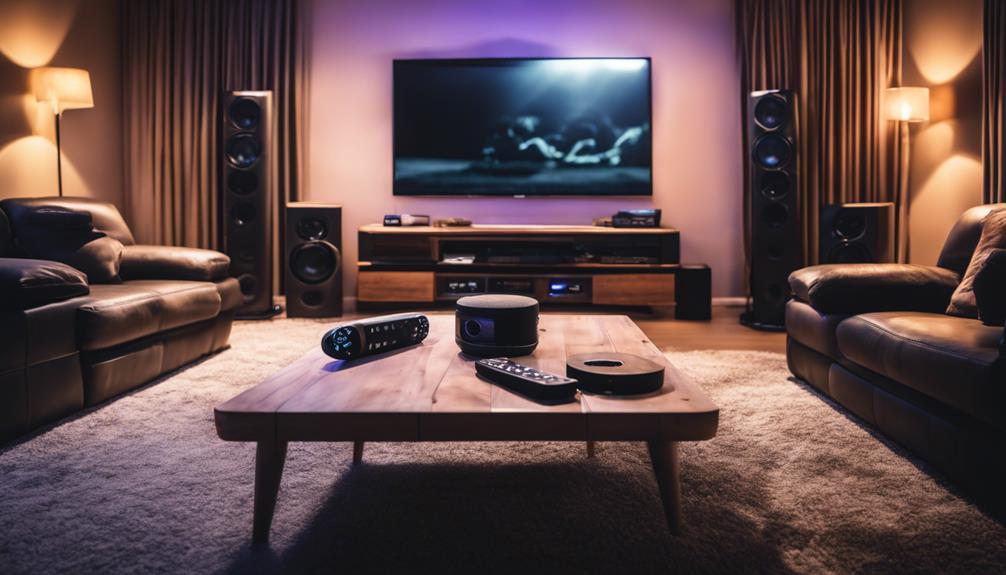
To keep your surround sound system performing at its best, regular maintenance and thoughtful setup adjustments are essential. Start by periodically inspecting and tightening all connections and cables. This prevents audio dropouts and guarantees peak performance. You should also adjust speaker positions as needed to adapt to changes in your room layout or furniture placement, which greatly affects sound quality.
Calibrate the sound balance of your system in your home at least once a month. This helps maintain clarity and immersion in your audio experience. Additionally, make sure to keep the firmware of your surround sound system updated to benefit from performance improvements and new features.
If you're considering complex setups or upgrades, consulting professional installers can be helpful.
| Maintenance Tips | Setup Adjustments | Benefits |
|---|---|---|
| Inspect connections monthly | Adjust speaker positions | Enhances sound quality |
| Calibrate sound balance | Regularly test system | Guarantees peak performance |
| Update firmware regularly | Seek professional help | Simplifies complex setups |
With these tips, you'll guarantee your surround sound speakers deliver the immersive experience you crave.
Budgeting for Your Setup
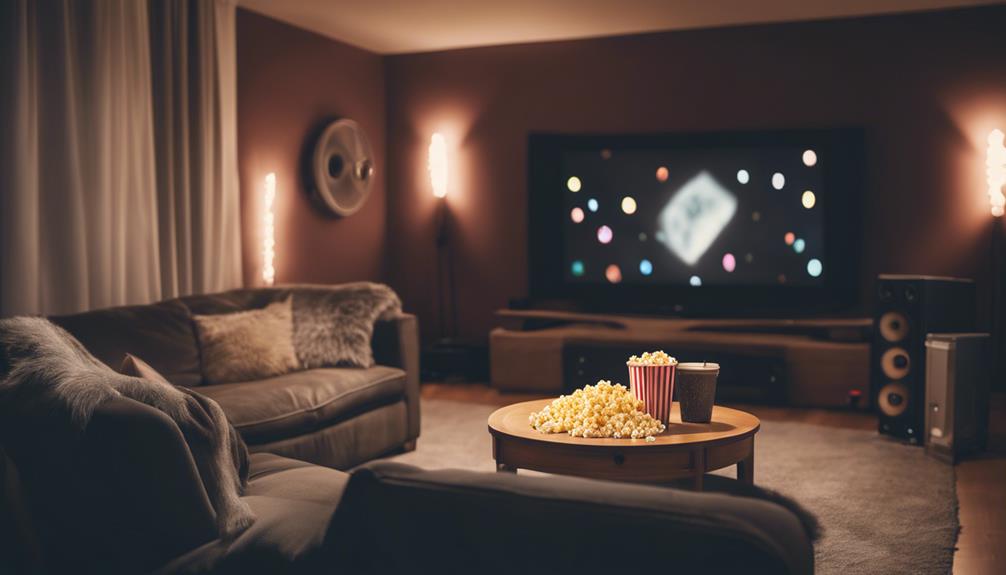
When budgeting for your surround sound setup, it's important to balance quality and affordability without breaking the bank. You can create an impressive home cinema experience by being strategic about your spending. Here are some tips to keep your costs in check:
- Start with a budget: Aim for around $1,000 to cover speakers, a receiver, and a subwoofer for a solid entry-level surround sound system.
- Research cost-effective options: You can find good quality speakers and receivers starting at around $300 for a basic 5.1 system.
- Shop online: Take advantage of discounts and promotions; many retailers offer seasonal sales saving you up to 30%.
- Use manufacturer websites: Look for coupon codes that can lower your costs by an additional 10-15%.
Frequently Asked Questions
Why Is Surround Sound Important?
Surround sound's important because it immerses you in audio, enhancing your experience. It captures subtle details, creating emotional connections, and offers realistic spatial awareness, making movies and games more engaging and enjoyable. You won't want to miss it!
What Is the Best Sound Setting for Home Theater?
Did you know 70% of moviegoers say sound quality impacts their viewing experience? For your home theater, aim for a 5.1 or 7.1 surround sound setup, ensuring speaker placement enhances clarity and immersion.
What Does Surround Sound Setting Do?
Surround sound settings distribute audio across multiple speakers, creating an immersive listening experience. You'll hear sounds from different directions, enhancing realism in movies and making you feel like you're part of the action.
Why Is Sound Important in Cinema?
Imagine the tension of a suspenseful scene; sound elevates that experience. It pulls you into the story, allowing you to feel every whisper and roar, creating an emotional connection that captivates your senses throughout the film.
Conclusion
So, you thought a big screen was all you needed for a great home cinema, huh? Well, think again!
Surround sound is where the magic happens, transforming your living room into a cinematic escape.
With the right speaker placement and room acoustics, you'll feel like you're right in the middle of the action—without ever leaving your couch!
So, don't just settle for visuals; give your ears the show they deserve, too.
After all, it's all about that immersive experience!
Tom is the Editor-in-Chief of 1home Theatre Projector, a website that provides news and reviews on the best home cinema experiences. With over 10 years of experience in the industry, Tom knows what makes a great home theatre projector and wants to make it easy for everyone to build the perfect setup for their needs. When he’s not busy writing or testing projectors, Tom enjoys watching classic films and spending time with his family.
